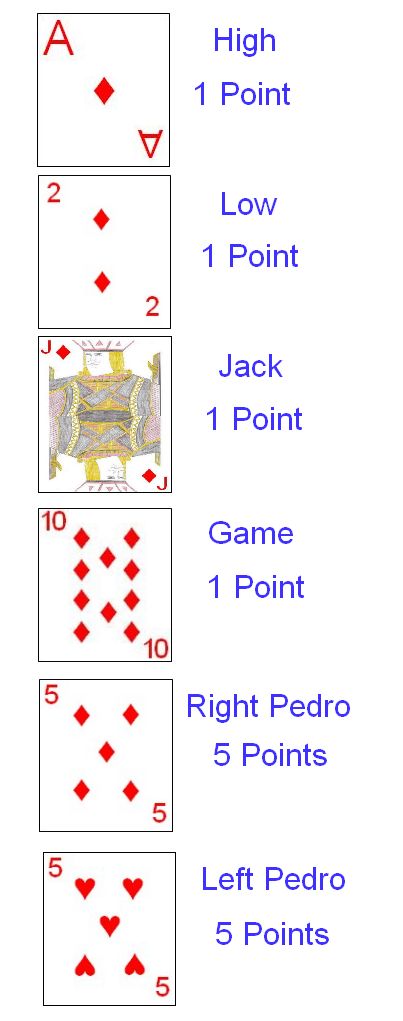
Cinch is a game of the All Fours family which was extremely popular in the early 20th century. Although still commonly played today, it is not nearly as popular as it once was. The game originated in Denver, Colorado and became popular throughout the rest of the United States and many other countries as well. Cinch is also played under the names High Five and Double Pedro.
This game is designed to be played by four players in two partnerships of two players each. If the partnerships have not been predetermined in some manner, the first order of business should be determination of these partnerships. This is often done by having all players randomly draw a card from a shuffled deck. The players drawing the two highest would play as partners against the players drawing the two lowest. The partners should sit directly across from each other at the table. The player who drew the highest card of all would be declared as the first dealer, with the deal then rotating around the table in a clockwise rotation.
Cinch uses the standard 52 card deck. The ranking of the cards when playing Cinch can vary somewhat dependent on which suit ends up being the trump suit for the hand:
- In the trump suit, the ranking is as follows (high to low): Ace, King, Queen, Jack, 10, 9, 8, 7, 6, 5 of Trump suit (called right Pedro), 5 of suit of same color as Trump suit (called left Pedro), 4, 3, 2. Note that the trump suit contains 14 cards, which includes the 5 of the same color but opposite suit as the suit actually designated as trump. For all purposes this five is considered a member of the trump suit and can and should be played any time that a card of the trump suit can legally be played.
- In the opposite suit of the same color as the trump suit, the ranking would be: Ace, King, Queen, Jack, 10, 9, 8, 7, 6, 4, 3, 2. Note that this suit only contains 12 cards as the five of this suit is actually considered a member of the trump suit.
- In the remaining suits, the ranking of the cards is: Ace, King, Queen, Jack, 10, 9, 8, 7, 6, 5, 4, 3, 2. Both of these suits contain the expected 13 cards.
After determination of partners and first dealer, the dealer deals the cards in face down three card packets in a clockwise rotation until each player has nine
total cards. After these cards are distributed, the players then examine their hands and a round of bidding begins. The player to the immediate left of the current dealer makes the first bid. A player's bid would be the total number of points he believes his partnership can earn during the hand if he is able to name the trump suit. A bid must be higher than any other bid during the hand, but a player may also make no bid, electing to pass instead. Each player has exactly one opportunity to bid or pass. The highest possible bid is fourteen, which is the maximum points which can be scored during one hand. Whichever player makes the highest bid is known as the bidder and will then have the privilege of declaring the trump suit for the hand. He so announces this trump suit without consulting with his partner. If the first three players pass, the dealer is required to name the trump suit but is not required to name an actual numerical bid.
After the trump is announced, a round of discarding then occurs. This begins with the player to the dealer's immediate left and proceeds in a clockwise rotation. Starting with this player, each player discards all non trump cards from their hand and places them face down to the side. These cards will take no further part in the hand. This player then tells the dealer how many cards he discarded and the dealer deals this many cards to that player from the deck. This continues for the next two players as well. When it's the dealers turn, he also discards and announces how many discards he is making. However, in the dealers case, after discarding, he instead has the opportunity to "rob the deck". That is, he takes the remainder of the deck and sifts through it, taking all remaining trump cards in it. If there are not enough trump cards remaining to return his hand to a full 6 cards, he may take any other cards he wants from the deck to obtain a 6 card hand. A player may never discard a card of the trump suit unless he is dealt more than six trump cards in his original dealt cards. In that case, he must display the trump card before discarding it so all players are aware that card is no longer in play. In the same way, if the dealer finds that between his hand and the remaining cards in the deck there are more than six cards of the trump suit, he must display any that he does not add to his hand. After the dealer takes as many cards as needed from the deck to bring his hand to six cards, the remainder of the deck and all the discarded cards are set aside, face down and will not be used again in the current hand.
After all players have thus discarded and drawn as appropriate, the high bidder than leads the first card to the first trick. A player on his turn, if able to play a card of the same suit as led to the trick, must either play such a card or may play a trump card. If unable to follow suit, the player may play any card to the trick, including a card of the trump suit. If a Trump card is led to the trick, a player must play any trump card if they possess one, otherwise they may play any card to that trick. The highest trump card in a trick wins the trick. If no trump cards were played to the trick, the highest card of the suit originally led to the trick wins it. The winner of each trick leads the first card to the next trick.
Once all six tricks have been played, the high bidder and his partner then examine the cards the partnership has won in tricks to determine if they have managed to earn at least as many points as he bid. Points are scored for capturing specific cards of the trump suit in tricks, as follows:
| Scoring Category | Description | Scoring Value |
|---|
| High | Ace of Trump Suit | 1 |
| Low | Two of Trump Suit | 1 |
| Jack | Jack of Trump Suit | 1 |
| Game | Ten of Trump Suit | 1 |
| Right Pedro | Five of Trump Suit | 5 |
| Left Pedro | Five of Opposite Suit | 5 |
If, between the high bidder and his partner, the partnership has managed to score at least as many points as bid, the bid is considered successful. In this case, the points earned by the lower scoring partnership during the hand are subtracted from the points earned by the higher scoring partnership and that difference is added to whichever partnership scored higher during the hand. It should be noted that the opponents can sometimes earn points on a successful bid. If both partnerships earn exactly the same number of points on the hand in this case, neither partnership scores for the hand.
If, on the other hand, the bidders' side did not manage to earn at least as many points as bid, the opponents partnership earns a score which is equal to their own number of points earned added to the high bidders actual bid on this hand.
In the situation where all players have passed and the dealer declared the trump suit but did not make a bid, each partnership adds to their score the number of points earned during the hand.
The first team to score 51 or more points at the end of any hand is declared the winner of the game.
Discard Any Card: Note that although the rules state that in the discard phase a player should discard all but the trump cards in his hand, many games impose no penalty for retaining non-trumps in his hand. Thus, some players dispense with this rule and allow all players (including the dealer) to retain his choice of any cards in the hand. However, as described in the standard game, a player may never discard a trump unless he retains more than six trump cards in his hand. In this case, he must display the trump card before discarding it so all players are aware that card is no longer in play. Players, of course, must discard a least three cards to reduce their hand to six cards.
Alternate Scoring: In order to simplify the scoring somewhat, some players modify the scoring method. Instead of subtracting totals and assigning the difference as in the standard version, some players prefer to award both partnerships the total number of points earned during the hand on a successful bid. If the high bidding partnership is unable to score the number of points bid, the opponents earn 14 points plus the number of points the high bidder was short of their bid.
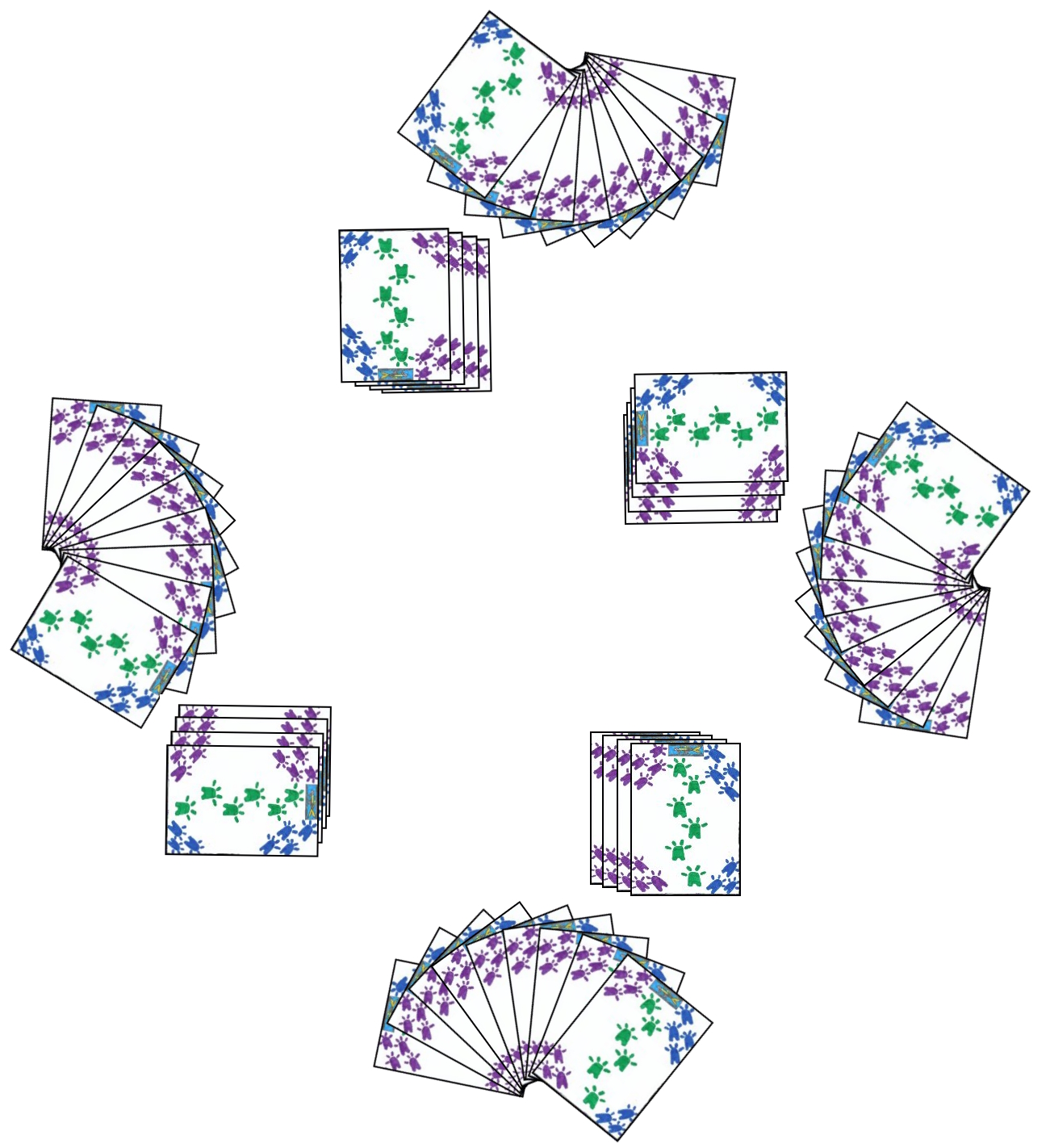 Cinch with a Widow:
Cinch with a Widow: A variant of Cinch which is sometimes played is "Cinch with a Widow". This variant is played similar to the standard game with the following differences:
- In the initial deal, in addition to the nine card hand, each player is dealt a four card widow hand, which is left face-down on the table. The players are not yet allowed to pick up or review this widow hand. This
four card widow is dealt to each player after the initial three card packet is dealt
around the table.
- As in the normal game, the player makes his bid based on his nine card hand as dealt. After the bidding has completed, the players pick up their widow hands, adding these four cards to their initial cards as dealt. After picking up the widow, the high bidder then declares his trump suit of choice.
- After the high bidder declares the trump suit to be used for the hand,
each player (including the high bidder) discards sufficient cards from his
hand to reduce his hand to six total cards, which will remain in his hand for play. All discarded cards are set aside and out of play. However, any player that discards one or more cards from the trump suit must show these cards to the other players before the discard.
In all other aspects, Cinch with a Widow is played identically to the standard version of the game.
Pedro: This game is one of the direct predecessors to Cinch (the other being All Fours). The game is sometimes spelled as Pedreaux in
some of the many locations where it is commonly played. The rules to Pedro are very similar to Cinch, with the following differences:
While in Cinch, the minimum bid is 1, in Pedro, the minimum bid is 7 points. If all players pass, the dealer must make a bid of 7, which makes him the high bidder for the hand and earns him the right to declare the trump suit for the hand.
The deal, discard and draw are all the same as in the standard game, except for with regards to the dealer. If the dealer finds, that between his own cards and those found while robbing the deck, there are more than six total trump cards total, he takes all these into his hand and thus may have a hand containing more than the normal six cards. In order to bring his hand to the expected total, he must play two cards to the first trick, one on top of the other. The top card of the stack is the card legally played to the trick. The card on the bottom can be any card from his hand (except one of the scoring cards in the hand) and has no affect on the trick itself. He is essentially just discarding one card of his choice into the trick and then playing his normal card to the trick.
The specific various scoring categories in Pedro are as follows:
| Category | Description | Scoring Value |
|---|
| High | Capturing the highest trump card in play. | 1 |
| Low | Being dealt the two of the Trump suit | 1 |
| Jack | Capturing the Jack of the Trump suit in tricks during the hand. | 1 |
| Game | Capturing the Ten of the trump suit in a trick. | 1 |
| Pedro | Capturing the Five of the trump suit in a trick. | 5 |
| Off-Pedro | Capturing the Five of the same color but different suit as the trump suit in tricks. | 5 |
| |
|
The scoring in Pedro is somewhat different than that in Cinch. The opposing partnership to the high bidder always scores the number of points they capture in tricks during the hand. If the bidders partnership manages to score at least as many points as bid, they add that score to their current total. If they do not win at least as many points as bid in the hand, they instead subtract the amount of their bid from their current score. Negative scores are possible. The first partnership to earn 62 or more points at the end of a hand is declared the winner.
One final rule difference is that of "bidder out". If both teams end a hand with less than 62 points but with more than 54 points, a "Bidder Out" situation occurs. During a "bidder out" situation, if the bidders' team manages to make their bid, they automatically win the hand, regardless of how many points they earn and how many points the opponents win. If they do not manage to make their bid, the opponents' score as normal. If both teams are still under 62 at the end of this hand, the following hand is also played as "Bidder Out".
A bidder out situation also occurs if both teams end a hand with 62 or more points and the previous hand was not a "Bidder out" situation, with the higher score winning at the end of this next "Bidder Out" hand.
Nicaraguan Pedro: This version, usually also called just Pedro, is commonly played in Nicaragua and the surrounding area.
Nicaraguan Pedro is played almost identically to standard Pedro with the following differences:
Each player is originally dealt seven cards by the dealer. After the trump is determined by the high bidder, the players then discard any cards from their hand of their choice and the current dealer then deals enough cards from the stock to restore their hand to seven cards. When it's the dealers turn he discards as normal. However, the dealer may look through the other players discards as well as the remaining stock for finding the cards he want to restore his own hand to seven cards.
The minimum starting bid is seven. However, if the first three players pass, the dealer must bid six. The highest bidder then declares the trump suit for the hand. The high bidder also leads to the first trick. In all other respects this variant is played identically to the standard version of Pedro.
Razzle Dazzle: Not to be confused with the notorious carnival con game with the same name, this is a version of Cinch which is normally played by five or six participants. There are no partnerships in this version and each player plays for himself. This game is also sometimes known by the name Auction Cinch.
Dealing and bidding are done the same as in standard Cinch as is the discard and draw. However, after the high bidder declares the trump suit, he also names a specific card of this trump suit (usually a high ranked one) which he does not have in his hand. Whichever other player has this card then becomes his temporary partner for the current hand. If no player has the card, it having been discarded, the high bidder plays alone. The player having the card must announce this, but no players trade seats or move for the hand.
If the original high bidder manages to make his bid, both he and his temporary partner score the full amount of points they earn as a partnership during the hand. However, if that partnership is unable to capture at least as many points as bid, all opponents score the amount of the high bidders bid added to the number of points they captured during the hand.
Sixty-Three: Sixty Three is another variant of Pedro, adding even more scoring cards in a hand. These cards are all scored by the partnership capturing the card in tricks. The following chart shows all scoring cards used in Sixty-Three:
| Scoring Category | Description | Scoring Values |
|---|
| High | Ace of Trump Suit | 1 |
| King | King of Trump Suit | 25 |
| Low | Two of Trump Suit | 1 |
| Jack | Jack of Trump Suit | 1 |
| Game | Ten of Trump Suit | 1 |
| Right Pedro | Five of Trump Suit | 5 |
| Left Pedro | Five of Opposite Suit as Trump Suit | 5 |
| Nine | Nine of Trump Suit | 9 |
| Three | Three of Trump Suit | 15 |
|
|
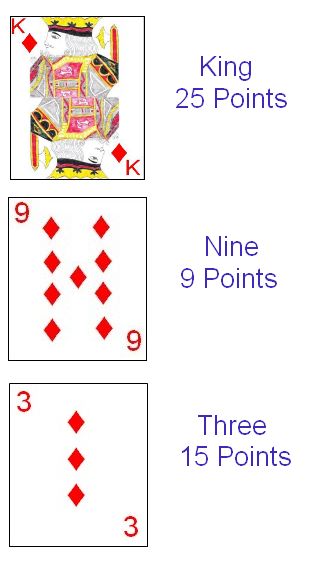 |
Bidding begins with the player to the dealer's left, continuing in a clockwise rotation around the table until there are three consecutive passes. A player must make a bid or pass. Each bid must be higher than any previous bid. The minimum bid is 1 and the maximum is 63.
After the bidding has been completed, four more cards are dealt to each player. Each player then examines his hand and discards seven cards from his hand to make a 6 card hand. Each player is not obligated to retain or discard any specific suit or cards, so can discard any cards of his choice from his hand. The discards are set aside, face down, and will not be used further in the current hand.
The first partnership to reach 152 points is declared the winner of the game. In all other respects, this game is played identically to standard Pedro.
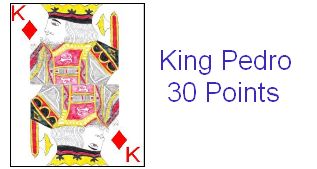 King Pedro
King Pedro: King Pedro is a direct descendant of the game Pedro and is played very similarly to the parent game.
The first and foremost difference is the addition of one more scoring card to those already normally scored for at the end of each hand. King Pedro, as the name suggests, adds the King of the Trump Suit, worth 30 points, to the list of scoring cards. All cards are scored for by the partnership capturing them in a trick except Low (Trump two), which will be scored for by the player who plays it to a trick (whether he wins that trick or not).
The minimum bid in this game is 30 and the maximum is 44 (the maximum points possible during a hand).
Another difference in this game is that the bidding continues until three consecutive players pass. Thus, a player may have multiple opportunities to bid during the same hand. A player may also elect to pass, but once passing, he may no longer make any bids during the current hand. A bid must be higher than any previous bid. The highest bidder then declares the trump card and takes the four card kitty as in Cinch or Pedro described above.
As in Pedro, if a player has more than six trump cards in their hand (due to being dealt more than six in the original deal), must discard one card of their choice to the first trick which has no bearing on the trick, and then play a second card to the trick. The second card is usually played on top of the first card. One difference in this version, however, is that the discarded card could also be a scoring trump, with the points going to the player winning the trick (unless it is the trump two, in which that player earns the score for the card).
If a trump card is first led to a trick, the other players must play a trump card if they possess one. If not, they may play any card. If a non-trump card is played to the trick, a player may play any card from his hand. The highest trump card in the trick wins it, or, if there are no trump cards in the trick, the highest card of the original suit led to the trick wins it. The winner of each trick leads the first card to the next.
The last difference between this game and standard Pedro is in the scoring. If the bidders partnership manage to score at least as many points as bid, they add the amount of points earned during the hand to their current accumulated score. If they are unable to earn at least as many points as their high bid, they must subtract the amount of their bid on the hand from their current score. The opponents of the high bidders partnership earn whatever points they earn during the hand. The first partnership to reach or exceed 200 total points is declared the winner. However, a partnership only wins when they reach 200 points after successfully making their bid. Thus, a team who reaches or exceeds 200 points but is not the high bidding team on the hand retain their score but are not declared the winner until they complete a successful bid. Thus, a partnership may win the game even if the other partnership has more points, but they are the first to make the next successful bid. If a partnership at any time reaches -100 points at the end of a hand, the opposing partnership is instantly declared the winner of the game.
Sancho: This game, also called Pedro Sancho and Nine-Five is another variant of Pedro. This variant is usually played by from 4 to 7 players, each playing for himself (no partnerships). The five of the opposite suit (Left Pedro) as the trump is not considered part of the trump suit in this version, and as such, does not earn any points for the winner of that card in tricks. In place of this card, however, the nine of the trump suit (called Sancho) earns nine points for whichever player earns it in tricks. Thus, the following are all the point scoring cards used in Sancho:
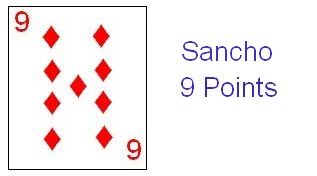 |
|
| Scoring Category | Description | Scoring Values | Scoring Order |
|---|
| High | Ace of Trump Suit | 1 | 1 |
| Low | Two of Trump Suit | 1 | 2 |
| Jack | Jack of Trump Suit | 1 | 3 |
| Game | Ten of Trump Suit | 1 | 4 |
| Pedro | Five of Trump Suit | 5 | 5 |
| Sancho | Nine of Trump Suit | 9 | 6 |
|
Each player receives exactly six cards in the deal, and unlike Pedro, players do not draw and discard in Sancho. There is one round of bidding, with a minimum bid of 1 and a maximum bid of 18, which is the maximum points possible during a hand. A player may either pass or make a bid, which must be higher than any previous bid. However, the dealer is one exception to this rule. He may, if he chooses, bid the same as the current high bid, which then makes him the Bidder. Once the bidding has been completed, the Bidder leads a card to the first trick. The card so led determines the trump suit for the hand.
As in most other games of the All Fours family, a player, if able to follow suit may follow suit or trump. If a card of the trump suit is led, he must play a trump card if able. If a player is unable to follow suit, they must trump if able, and if having no trump cards, they may play any card to the trick. The trick is won by the highest trump card played to the trick, or, in the absence of trump cards, the highest card of the suit led. The winner of each trick leads the first card to the next trick.
If the Bidder was able to earn at least as many points as bid, every player scores the number of points they captured during the hand. If the bidder does not earn at least as many points as bid during the hand, no one scores and the bidder must subtract the full amount of his bid from his current score. The first player to reach or exceed 100 accumulated points is declared the winner. If more than one player reach or exceed this goal in the hand, the points are added in the order shown in the Scoring Order column of the chart above.
Dom Pedro: This is a rarely played game which bears a striking resemblance to Sancho. In fact, the game is played identically to Sancho with just a few exceptions (see below). This game is also commonly called Snoozer.
The first major exception is that in Dom Pedro, one Joker (called Dom or Snoozer) is added to the deck used in playing the game. This Joker is considered the lowest card in the trump suit, ranking below the 2. A partnership capturing this Joker earns 15 points for doing so. With the addition of the Joker, the following chart shows the value and scoring order for all scoring cards used in this game:
| Scoring Category | Description | Scoring Values | Scoring Order |
|---|
| High | Ace of Trump Suit | 1 | 1 |
| Low | 2 of Trump Suit | 1 | 2 |
| Jack | Jack of Trump Suit | 1 | 3 |
| Game | 10 of Trump Suit | 1 | 4 |
| Three | 3 of Trump Suit | 3 | 5 |
| Pedro | 5 of Trump Suit | 5 | 6 |
| Sancho | 9 of Trump Suit | 9 | 7 |
| Dom | Joker | 15 | 8 |
|
|
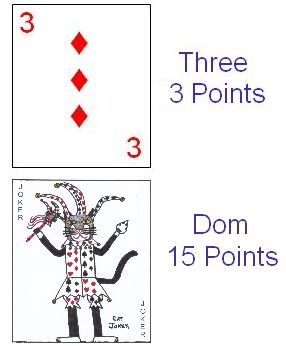 |
|
The first player to reach or exceed 100 points is declared the winner. If two or more players reach this total in the same hand, the scores should be added to the individual player's scores as shown in the scoring order in the chart above. In all other aspects this game is played identically to Sancho.
Pidro: Pidro is a Finnish variant of Cinch which is very similar to Pedro and is extremely popular in many areas of Finland. It is played identically to regular Pedro with the following being the only differences:
- The minimum bid for any player (including the dealer) is 6 and the maximum is 14 (which is the maximum number of points that might be earned during a hand).
- After all other players have finished their discard and draw, the dealer than takes the remainder of the deck adding it to his initial 9 card hand. He then discards as many cards as necessary to return his hand to 6 cards.
- Non-Trump cards are never actually played to a trick. Once a player runs out of trump cards in their hand, they lay down the remainder of their hand and take no further part in the play of the hand. If that player had won the previous trick, the lead for the next trick rotates to the next player in turn who still has cards of the trump suit. If all players but one run out of cards of the trump suit, the last player with any trump cards automatically wins all remaining tricks in the hand.
- If the bidders are able to earn as many points during the hand as bid, they add that total to their score. If they are unable to earn at least as many points as bid, the total of their bid is subtracted from their current ongoing score. The opposing partnership to the bidder earns whatever points they manage to capture during the hand.
- The first team to earn more than 61 points during the game is declared the winner. If both teams exceed 61 points during the same hand, the bidding team is set as the winner (even if the opponents have earned a higher total score).
Copyright © 2015 CatsAtCards.com. All rights reserved.
 Cinch is a game of the All Fours family which was extremely popular in the early 20th century. Although still commonly played today, it is not nearly as popular as it once was. The game originated in Denver, Colorado and became popular throughout the rest of the United States and many other countries as well. Cinch is also played under the names High Five and Double Pedro.
Cinch is a game of the All Fours family which was extremely popular in the early 20th century. Although still commonly played today, it is not nearly as popular as it once was. The game originated in Denver, Colorado and became popular throughout the rest of the United States and many other countries as well. Cinch is also played under the names High Five and Double Pedro.




